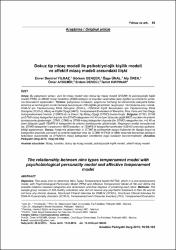| dc.contributor.author | Yılmaz, Enver Demirel | |
| dc.contributor.author | Gençer, Görkem | |
| dc.contributor.author | Ünal, Özge | |
| dc.contributor.author | Örek, Alp | |
| dc.contributor.author | Aydemir, Ömer | |
| dc.contributor.author | Deveci, Erdem | |
| dc.contributor.author | Kırpınar, İsmet | |
| dc.date.accessioned | 2019-01-07T20:09:45Z | |
| dc.date.available | 2019-01-07T20:09:45Z | |
| dc.date.issued | 2017-06-19 | |
| dc.identifier.issn | 1302-6631 | |
| dc.identifier.uri | http://hdl.handle.net/11363/816 | |
| dc.description.abstract | Objective: This study aims to determine Nine Types Temperament Model (NTTM), which is a new temperament model, with Psychobiological Personality Model (PPM) and Affective Temperament Model (ATM) and define the possible relations between categories and dimensions and their degrees of predicting each other. Methods: The sample group consists of 206 healthy volunteers who did not receive any psychiatric treatment in their life and do not have any chronic disease. Structured Clinical Interview for DSM-IV (SCID-I), Structured Clinical Interview for DSM-III-R personality disorders (SCID-II), Temperament and Character Inventory (TCI), Temperament Evaluation of Memphis, Pisa, Paris and San Diego Autoquestionnaire Version (TEMPS-A) and Nine Type Temperament Scale (NTTS) were used to collect data. Results: Except for NTM3, NTM8 and NTM9 temperament categories, all NTTS categories have significant correlation with various TCI dimensions at a level r=0.40 and above. Except for NTM1, NTM5 and NTM9 temperament categories, all NTTS categories have significant correlation with various TEMPS-A categories at a level r=0.40 and above. According to the results of regression analyses, it is found that TCI dimensions and TEMPS-A categories can explain 29-63% of variance of NTTS temperament categories. Conclusion: This study indicates that although there are consistent and significant correlations between dimensions and categories of NTTS and the two scales widely used in psychiatry, there are conceptual differences between NTTM, PPM and ATM and temperament categories of NTTM have unique features. | en_US |
| dc.description.abstract | Amaç: Bu çalışmanın amacı, yeni bir mizaç modeli olan Dokuz Tip Mizaç Modeli (DTMM) ile Psikobiyolojik Kişilik Modeli (PKM) ve Affektif Mizaç Modelinin (AMM) kategori ve boyutları arasındaki olası ilişkileri ve birbirlerini yordama derecelerini saptamaktır. Yöntem: Çalışmanın örneklemi, yaşamının herhangi bir döneminde psikiyatrik tedavi görmemiş ve herhangi bir kronik hastalığı bulunmayan 206 sağlıklı gönüllüden oluşmuştur. Veri toplama aracı olarak DSM-IV için Yapılandırılmış Klinik Görüşme (SCID-I), DSM-III-R Kişilik Bozuklukları için Yapılandırılmış Klinik Görüşme (SCID-II), Mizaç ve Kişilik Ölçeği (MKÖ), Temperament Evaluation of Memphis, Pisa, Paris and San Diego Autoquestionnaire Version (TEMPS-A) ve Dokuz Tip Mizaç Ölçeği (DTMÖ) kullanılmıştır. Bulgular: DTM3, DTM8 ve DTM9 mizaç kategorileri dışında tüm DTMÖ kategorileri r=0.40 ve üzerinde çeşitli MKÖ boyutları ile anlamlı korelasyonlar göstermiştir. DTM1, DTM5 ve DTM9 mizaç kategorileri dışında tüm DTMÖ kategorileri ise, r=0.40 ve üzerinde çeşitli TEMPS-A kategorileri ile anlamlı korelasyonlar göstermiştir. Regresyon analizi sonuçlarında ise, DTMÖ kategorileri varyansının MKÖ boyutları ve TEMPS-A kategorileri tarafından %29-63 oranında açıklanabildiği saptanmıştır. Sonuç: Araştırma göstermiştir ki, DTMÖ ile psikiyatride yaygın kullanıma sahip iki ölçeğin boyut ve kategorileri arasında çok tutarlı ve anlamlı bağıntılar olsa da, DTMM ile PKM ve AMM arasında kavramsal yaklaşım farklılıkları bulunmakta ve DTMM’nin mizaç kategorileri kendilerine özgü özellikler barındırmaktadır. | |
| dc.language.iso | tur | en_US |
| dc.publisher | CUMHURIYET UNIV TIP FAK PSIKIYATRI ANABILIM DALI, CUMHURIYET UNIV TIP FAK PSIKIYATRI ABD, SIVAS, 58140, TURKEY | en_US |
| dc.relation.isversionof | 10.5455/apd.164248 | en_US |
| dc.rights | info:eu-repo/semantics/openAccess | en_US |
| dc.rights | Attribution-NonCommercial-NoDerivs 3.0 United States | * |
| dc.rights.uri | http://creativecommons.org/licenses/by-nc-nd/3.0/us/ | * |
| dc.subject | Research Subject Categories::MEDICINE::Psychiatry | en_US |
| dc.title | Dokuz tip mizaç modeli ile psikobiyolojik kişilik modeli ve affektif mizaç modeli arasındaki ilişki | en_US |
| dc.title.alternative | The relationship between nine types temperament model with psychobiological personality model and affective temperament model | en_US |
| dc.type | article | en_US |
| dc.relation.ispartof | Anadolu Psikiyatri Dergisi | en_US |
| dc.department | İstanbul Gelişim Üniversitesi | en_US |
| dc.identifier.volume | 16 | en_US |
| dc.identifier.issue | 2 | en_US |
| dc.identifier.startpage | 95 | en_US |
| dc.identifier.endpage | 103 | en_US |
| dc.relation.publicationcategory | Kategori Yok | en_US |



















